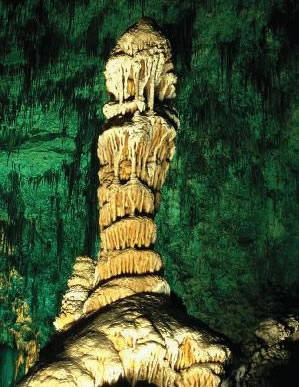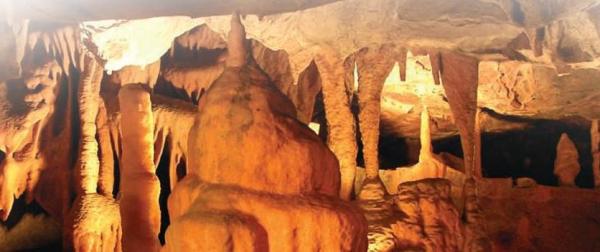Formation

In its pure state, water is acid-free. However, as
rainwater falls through the atmosphere and as it passes
through decaying
Stalagmites/Stalactites
Caves vary in size, shape and content; but they all include spectacular formations. The two most well-known speleothems are stalactites and stalagmites, but many confuse the two. One way to remember the one on the cave’s ceiling is that they hang “tite” to the ceiling—stalactites. Stalagmites, on the other hand, “mite” rise from the floor of these underground worlds. These formations result when this mixture of water and calcite enters a cave. The solution goes through a reaction where CO2 bubbles away, and the calcite is deposited in formations called speleothems. Stalagmites result from the calcite collecting on the floor directly below a stalactite, which forms by calcite collecting on the ceiling. If the two join together, they become known as a column. Other speleothems include flowstones, draperies, soda straws, and helectites.
Dates
Evolutionary explanation
According to evolutionary geologists, beginning about
300

Biblical explanation
Most of the major limestone layers show evidence that they were laid down by large amounts of water. They contain large numbers of catastrophically buried fossils. It is probable that they formed during the global Flood of Noah’s day (Genesis 6–9), when lime-rich volcanic waters gushed from springs on the ocean floors. These limestone layers were then buried rapidly by other layers of sediment, trapping considerable amounts of water within each limestone layer. Naturally, these layers began to harden over time; however, the water within each layer retarded this process and kept the limestone pliable. In the after-effects of the Flood, great tectonic activity would have uplifted the limestone layers, bringing them closer to the surface. Bent and twisted layers of rock are seen today, testifying of these movements. These movements not only created fractures in the partially hardened layers of limestone, but the extreme pressure also forced out much of the trapped water within these layers. The water then began to flow along the horizontal and vertical channels, which had also been produced by the earth’s tectonic activity.
It is likely that the tectonic activity of the earth also released hydrogen sulfide, combining with ground water to create sulfuric acid that could have swiftly eaten away tremendous amounts of limestone. In addition, as the floodwaters receded completely from the earth’s surface, the groundwater would have taken some time to reach a balanced level. The water flowing beneath the earth’s surface would have been tainted with acid from the great amounts of decaying organic matter above after it seeped through the first few layers of soil. With such extreme amounts of acidic water, the caves would have been carved out in a short time.
Speleothems such as stalagmites and stalactites have also been found to form rapidly under the right conditions. It is observed that the caves and their formations found in tropical rain forests form much more rapidly due to the increased rainfall.
Consider it
Caves and their formations did not need many millions of years to form, they could have formed rapidly during the closing stages of, and after, the worldwide Flood of Noah’s day. With the incredible amounts of water from the Flood, the increased carbon levels from all the decaying matter and the related tectonic activity, the global Flood described in Genesis 7–8 produced the right conditions for caves to form very quickly.